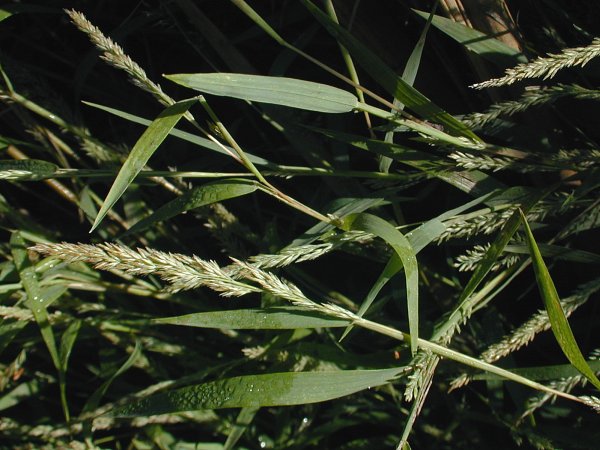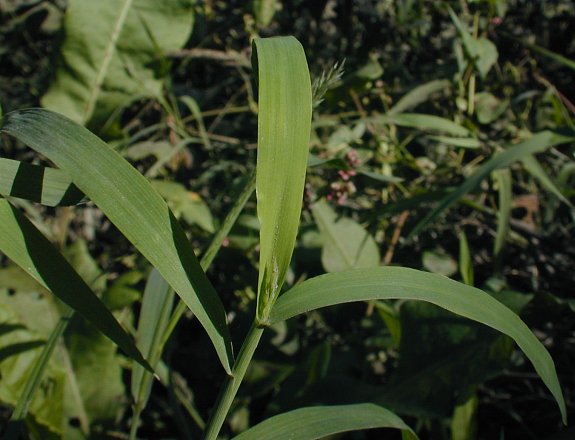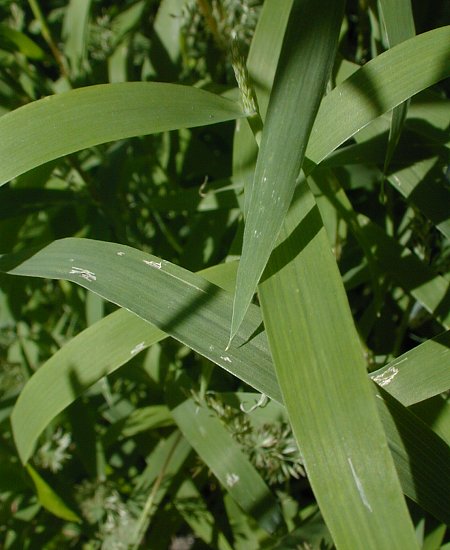Description: This perennial grass is about 1½–2½' long, forming short lateral branches along the central culm. This grass usually sprawls across the ground or on neighboring vegetation, although it is sometimes more erect. The central culm is slender, terete, glabrous, and light green to light reddish green (but becoming tan after the blooming period). There are 6-12 alternate leaves along the central culm and fewer alternate leaves along the lateral branches. The leaf blades are up to 4" (10 cm.) long and 7 mm. across; they are widest toward the middle or lower-middle, hairless, and flat. The upper blade surface is medium green and dull-colored, while the lower blade surface is pale green. The leaf sheaths are light to medium green, hairless, and usually shorter than the internodes of the culm. The ligules are 1-1.5 mm. long and stiff-membranous, while the nodes are short, swollen, and glabrous. The central culm terminates in a narrow panicle of spikelets up to 4" long and ¾" across. This panicle has about 6-12 appressed to ascending branchlets that are up to 1" long. Pedicellate spikelets occur near the bases of these branchlets to their tips; they are densely distributed and abundant. Axillary panicles also develop from the middle to upper leaves on short lateral branches; these axillary panicles are smaller than the terminal panicle, otherwise they are similar in appearance.

The panicles are either sessile to the uppermost leaves, or they have short peduncles up to ¾" long. The peduncles, rachis (central stalk), branchlets, and pedicels of the panicles are light green and hairless. While the florets are blooming, these panicles spread outward to their maximum extent (about ¾" across), becoming broadest toward the middle or lower-middle. At this time, they are shiny light green (sometimes with pale purplish tints). After the florets have bloomed, the panicles contract their branches, becoming more narrow, and they become light tan. Each spikelet consists of a pair of narrowly lanceolate glumes, a narrowly lanceolate lemma, and a membranous palea; the glumes, lemma, and palea are about 2-3 mm. long. On rare occasions, the lemmas have short awns (1-2 mm. in length), otherwise they are awnless. Each floret has 3 anthers, a pair of plumose stigmas, and an ovary. The blooming period occurs during late summer or autumn, lasting about 1-3 weeks for a colony of plants. The florets are cross-pollinated by the wind. Disarticulation of the spikelets is above the glumes. At this time, the small grains are enclosed by an adherent pericarp consisting of their lemmas and paleas. The root system is fibrous and long-rhizomatous. This grass often forms clonal colonies.

Cultivation:
The preference is light shade to full sun, moist to mesic conditions,
and a fertile loamy soil, although other kinds of soil are tolerated.
Sometimes this grass can spread to places where it isn't wanted, but
there are more aggressive grass species than this. It is rather slow to
develop and doesn't become conspicuous until later in the year.
Range & Habitat:
Common Satin Grass is common in most areas of Illinois, although its
distribution is more spotty in some central and south central areas of
the state (see Distribution
Map). This grass is native. Habitats
include openings in moist woodlands, woodland borders, bottoms of
bluffs, bases
of wooded slopes, moist depressions of cliffs, prairie swales,
disturbed areas of black soil prairies, low
areas along ponds, river banks, drainage ditches, fence rows, edges of
fields,
edges of back alleys in cities, areas along railroads, and roadsides.
This
grass is typically found in disturbed areas that are partially shaded.
It has low fidelity to any particular habitat.

Faunal
Associations:
Larvae of a gall fly, Astictoneura
agrostis, form scaly galls on Common Satin Grass (Muhlenbergia frondosa).
Other insects that feed on this grass and other satin grasses (Muhlenbergia spp.)
include larvae of the gall fly Astictoneura
muhlenbergiae, larvae of the gall wasp Eurytomocharis muhlenbergiae,
larvae of the grass fly
Homaluroides ingratus, the stink bug Hymenarcys nervosa,
the leafhoppers Flexamia
imputans and Plesiommata
tripunctata, and such aphids as Anoecia cornicola
and Schizaphis
muhlenbergia. See the Insect Table for
more information
about these species. The small seeds of satin grasses are probably a
minor source of food for some birds, and the young foliage is palatable
to cattle and other hoofed mammalian herbivores. Because Common Satin
Grass often grows in dense colonies, it provides cover for small
rodents and other wildlife.
Photographic Location:
A low moist area along a drainage ditch in Savoy, Illinois, and edge of
a field near the Loda Cemetery Prairie in east-central Illinois.

Comments: This grass is often encountered in areas that are damp, overgrown, and weedy, although few people recognize it. Only the inflorescence has a satiny appearance, and that lasts only a short period of time. Common Satin Grass (Muhlenbergia frondosa) was once regarded as another variety of Leafy Satin Grass (Muhlenbergia neomexicana), although they are now considered separate species. Because Common Satin Grass and Leafy Satin Grass are very similar in appearance, they are difficult to distinguish. However, the culms of Common Satin Grass are glabrous and smooth-textured, while the culms of Leafy Satin Grass are finely short-pubescent, especially underneath the nodes. The ligules of Common Satin Grass are usually longer (1-1.5 mm. in length) than those of Leafy Satin Grass (0.5-1 mm. in length). Leafy Satin Grass tends to be more erect and less branched than Common Satin Grass, but this distinction isn't always reliable. Many other satin grasses (Muhlenbergia spp.) have panicles that are even more narrow (up to ¼" across) than those of Common Satin Grass and Leafy Satin Grass, and some species have awns on their spikelets that exceed 2 mm. in length. Another species, Muhlenbergia racemosa (Marsh Muhly), has panicles that are just as broad (up to ¾" across), but it has longer glumes (4-8 mm. in length).